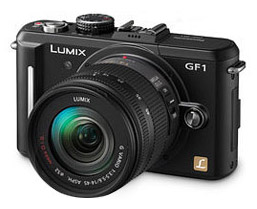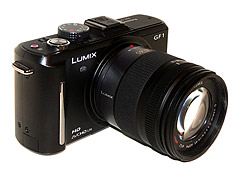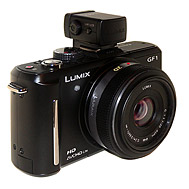The Panasonic GF1 camera has been generating an enormous amount of buzz for the past few months, and, even with a relatively high price tag, it continues to be in short supply. What's the deal?

To answer that, we have to briefly dig into what is called the Four Thirds Standard, which is a camera system devised specifically for digital photography by Olympus and Kodak. The Four Thirds Standard uses refined lens design that works better with digital image sensors than do lenses made for use with film. It is an open standard used by several manufacturers including Olympus, Leica, and Panasonic.
With film photography, the larger the film format, the higher the image quality. A medium-format negative produced with a Hasselblad camera will have finer detail and smoother tonal gradation than a smaller negative produced by a Nikon/Canon 35mm camera. In digital photography, an equivalent principal operates. The larger the camera's sensor, the less electronic noise will be present in the image.
Until recently, digital cameras have fallen into two general categories: non-interchangable lens "compacts" that are popular with casual snapshooters, and digital single-lens reflex (DSLR) cameras that are used widely by professionals and serious amateurs. Of these, the compacts have very small sensors, and the DSLRs have larger sensors. To over-simplify a bit, the compacts usually have a sensor that is approximately 1/8th the size of a 35mm negative, and the DSLRs have sensors approximately 1/4th the size of a 35mm negative. The larger sensor of the DSLR results a higher signal-to-noise ratio and therefore higher-quality photographs. (Some DSLRs have "full-frame" sensors that are the size of a full 35mm negative but these are quite expensive and quite large pro-level systems and, if you possess one of them, you're probably not interested in this article.)
Since the Four Thirds sensor is smaller that a 35mm negative, it is possible to manufacture Four Thirds lenses with narrower coverage that are physically smaller than lenses used on 35mm cameras. The first Four Thirds cameras took advantage of this and were basically scaled-down DSLRs. Though these cameras were smaller than full-sized DSLRs, they were still considerably larger and less convenient to carry than compact digitals. This is where the Micro Four Thirds system comes in.
The reason for the bulk of the initial Four Thirds DSLRs was that they were still DSLRs, meaning that they had the usual reflex viewing system that required space within the camera body for a moveable mirror and prism to provide through-the-lens viewing. In 2008, Olympus and Panasonic announced the Micro Four Thirds system which eliminated the reflex viewing mechanism in favor of electronic viewing either via display on the camera back or with an electronic viewfinder. This allows the size of the camera to be greatly reduced.
With the arrival of the Panasonic GF1 and its rival the Olympus E-P2, the potential of the Micro Four Thirds standard has been realized. Though not as tiny as compacts, these cameras are very small in size, have interchangeable lenses, large image sensors, and are capable of producing professional-quality photographs.
In your hand, the GF1 feels solid and well-constructed with nice heft and good gripping surfaces. It has the usual controls found on current digital cameras, most of which are accessible with your right thumb. The camera is easy to use and becomes second-nature very quickly.
Its Four Thirds sensor contains 12.1 megapixels and dust-reduction technology to keep its surface clean. It has a 3" LCD monitor, but no built-in viewfinder. (An optional electronic viewfinder is available; see below.) It has built-in flash suitable for light duty use only. For serious flash photography, an external flash unit can be mounted in the hot shoe provided.
Unlike most compacts, the GF1 auto-focuses very quickly and decisively. It also allows old-school manual focus by rotating the focus ring on the lens, and it can be configured to automatically enlarge the image on the viewfinder to increase accuracy when manual focus is used. Camera movement compensation (image stabilization) is built into GF1 lenses rather than the camera body, and not all lenses have it. In addition to standard focus modes, the GF1 has face-detection and automatic tracking to lock onto a moving subject.
The GF1 also shoots 720P HD video, though audio quality is mediocre mono and there is no external microphone connection. The video capabilities should be considered a nice bonus for casual use but not in any way comparable to a dedicated video camera.
The camera is available in two kits, one with a 14-45mm F3.5-5.6 zoom lens and the other with 20mm F1.7 "pancake" fixed-focus lens. This is where things get interesting. With the 14-45mm zoom lens (28-90mm equivalent in 35mm photography), the GF1 is a very capable general purpose camera, but is once again pushing the size limits of a compact. The zoom lens protrudes from the camera enough to make it no longer pocketable.

With the 20mm fixed-focus "pancake" lens (40mm equivalent in 35mm photography), the GF1 is truly small, mobile, and agile. Using it in this configuration is surprisingly similar in feel to shooting an old Leica rangefinder. Adding the external viewfinder completes this package, and it could be argued that the result is a system better suited to street photography than nearly any other digital camera currently available - except a digital Leica, of course.

The Micro Four Thirds cameras and in particular the Panasonic GF1 are changing the photographic playing field. At a time when it seems that camera manufacturers have little to offer beyond the addition of a few more pixels every year, these cameras are something different. Their high-quality images, versatility, and small size are truly innovative--and they are great fun to use.
Jay Boersma
www.re-vision.com